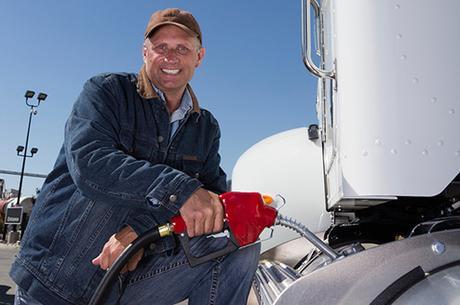 How much do fuel costs affect your bottom line? For most, it is a top 3 expense, along with driver pay and equipment. Like any monster, it can—and must—be held at bay. That fact should rouse your inner manager—you know, the one who wakes you up at 3 a.m. in search of answers.
How much do fuel costs affect your bottom line? For most, it is a top 3 expense, along with driver pay and equipment. Like any monster, it can—and must—be held at bay. That fact should rouse your inner manager—you know, the one who wakes you up at 3 a.m. in search of answers.
Ready for help fighting down fuel expenses? Trucker, small fleet owner, accountant and Sirius XM radio host, Kevin Rutherford, has been a champion of using fuel management techniques for years. Within the many Dollars & Sense columns he’s written for Overdriveonline.com, you’ll find ideas for lowering fuel costs with simple strategies that improve the bottom line.
Here’s a collection of those fuel-cost management methods:
Slow and Steady – It’s hard to reconcile the idea of taking longer with each run…until you get an idea of what it can save. According to Kevin Rutherford and Overdriveonline, “Slowing down 1 mile per hour will improve fuel economy by 1/10 of 1 mile per gallon. That may seem small, but it equates to about $1,000 each year in most operations. That’s pretty easy math: Slowing down 5 mph puts $5,000 to the bottom line, while 10 mph works out to a $10,000 raise.”
Shift for Savings – Progressive shifting is an acquired skill, and one that has to be practiced. Simply stated, progressive shifting uses the lowest possible rpm to shift into the next highest gear. This avoids the fuel gulping that occurs when you stomp on the gas to achieve cruising speed faster. But it does take patience. Done right, after each shift, both engine and transmission will be running near the lowest manufacturer-recommended rpm speeds. This burns far less fuel.
Rutherford says, “Work on progressive shifting to improve fuel economy and extend the life of your tires and driveline. Get the truck moving with the lowest-possible rpm in each gear. If you’re not actively practicing this technique, it’s easy to get into the habit of winding out each gear to a much higher rpm.
Be a Smooth Operator – In its study of driving habits as they relate to fuel consumption of class 8 vehicles, data firm SmartDrive said, “80% of fuel waste can be improved by softer driving.” That means achieving a higher awareness of actions including:
- Smooth acceleration/deceleration
- Braking
- Turning
- Speeding
“Most of us tend to drive on autopilot,” Rutherford says, “but that doesn’t save fuel. Imagine that you have a raw egg on the bottom of your shoe and you’re trying not to break it by putting easy pressure on the throttle and also the brake. This requires you to focus on your driving, as well as looking further down the road and planning.”
Improve Your Grades – Negotiating mountain roads, hills and other steep grades can really guzzle fuel, unless you know what you’re doing. In addition to practicing “smooth driving” as previously described, experts advise paying close attention to your boost gauge and the pyrometer. “On rolling hills or hard climbs, take the truck off cruise control and drive it using this technique,” Rutherford says. “Anticipate the hill and increase speed just slightly with light easy pressure on the throttle. Downshift a little earlier and work to keep the boost and pyrometer low, finding the gear that allows you to climb the hill without the throttle to the floor. You know you’re in the right gear when you still can accelerate if necessary.”
The Surcharge Surge – One other way to manage fuel costs is to understand how to calculate fuel surcharges to maximize profits. Rutherford offers the following math as a way for truckers and fleets to protect themselves from fuel cost fluctuations:
• A base fuel price – When the fuel is above the base price, the surcharge will be calculated and applied.
• Base fuel mileage – Typically 6 miles per gallon.
• The source and interval of the current fuel price – National and regional average prices are published every Monday by the U.S. Department of Energy.
The additional profits kick in when you drive smart like we’ve shown above. As you improve fuel consumption, the surcharge effectively lowers your price per gallon. And when fuel prices rise, that spread gets better too. As Rutherford says, “Because fuel surcharge calculations involve some sort of fuel mileage average, a fuel-efficient owner-operator or small fleet owner can always beat the averages.”
Driving smart takes more planning and more patience, but in the end, it can have a massive impact on earnings.

